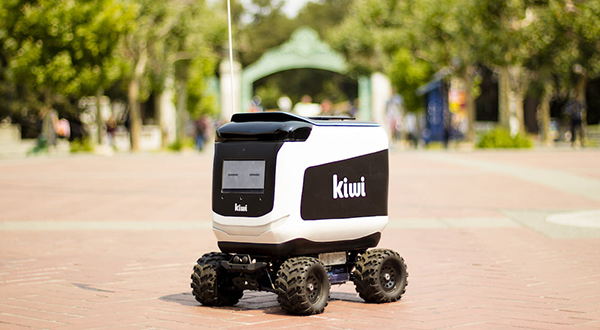The landscape of food delivery is changing fast. The take-away trend impacted many traditional dine-in restaurants. Then, platforms like UberEats and Foodora took over the take-away industry. Now, food delivery robots are on the rise: either flying through the air with drone technology like UberElevate, or cruising on sidewalks like the Kiwibot.
However, these robots have not always been performing without mistakes. In 2018, a Kiwibot caught fire on the campus of the University of California, Berkely. In 2017, a robot ‘drowned’ when it fell into a decorative fountain. One witness of the drowning robot summed up his faith in technological innovation “We were promised flying cars, instead we got suicidal robots”. This quote perhaps reflects one of the important barriers to these innovations: will society accept robots in their life? If yes, under what conditions?
There are some obvious safety risks involved in these experiments and the eventual realization of robotics in these everyday applications that need to be closely monitored. Whilst the Kiwibot that drove around in flames, or Steve the “suicidal” robot in the fountain mostly made people laugh, some autonomous robots have caused serious accidents, severely injuring people around them.
In addition to safety risks, many people complain about robots taking over their jobs. For example, in this video – in which they are trying to steal the food from one of the delivery robots – one of the delivery employees from another platform gets angry at the small delivery robot cruising by, as she indicates it is ‘her’ territory.
However, on a more positive note, for us as consumers drone delivery may enable access to restaurants that were previously out of reach, like ordering from your favorite brunch restaurant on the beach. Or it can become cheaper or perhaps even free to have food delivered with robots like the Kiwibots on campus or business districts.
It is understandable that platforms are trying to differentiate their offer so they provide superior value to its customers, but are delivery robots or drones the way to do it? What value or harm do you see in these new ways of food delivery?
Sources:
- BBC News. (2019). Bear spray accident hurts Amazon workers. [online] Available at: https://www.bbc.com/news/world-us-canada-46468719 [Accessed 2 Oct. 2019].
- C., Rajko, A., Schumacher, T. and Wrulich, M. (2016). The changing market for food delivery. [online] McKinsey & Company. Available at: https://www.mckinsey.com/industries/high tech/our-insights/the-changing-market-for-food-delivery [Accessed 17 Sep. 2019]. Isaac, M. and Yaffe-Bellany, D. (2019). The Rise of the Virtual Restaurant. [online] The New York Times. Available at: https://www.nytimes.com/2019/08/14/technology/uber-eats-ghost-kitchens.html [Accessed 20 Sep. 2019].
- Grant, C. (2019). Human-guided burrito bots raise questions about the future of robo-delivery. [online] The Hustle. Available at: https://thehustle.co/kiwibots-autonomous-food-delivery/ [Accessed 2 Oct. 2019].
- Fisher, C. (2019). Uber Elevate plans to deliver Big Macs by drone this summer. [online] Engadget. Available at: https://www.engadget.com/2019/06/12/uber-elevate-drone-deliveries-san-diego/?guccounter=1&guce_referrer=aHR0cHM6Ly93d3cuZ29vZ2xlLmNvbS8&guce_referrer_sig=AQAAAKugXZb4aqLzRbS0ZrxUFL4DUmLIIkvE8mTb6mFq9gDv5GsERdQv6sMJwT8qo5IHJ-2QM2Yb4sHohSf-wVl0ksffoIsgLpgRy5PjlfZr4LyEAyjmqdKoSVjCZcLNyL3NuQdo4fcK7mV7NQG4zjWMtWHKaf5LV8taP0AJB9xo_cDj#targetText=Kate%20Fraser%2C%20head%20of%20policy,jump%20year%2Dover%2Dyear. [Accessed 2 Oct. 2019].
- Steinberg, Y. (2019). “He Looked So Happy” ‘Suicidal’ security robot called Steve is found drowned in a water fountain. [online] The Sun. Available at: https://www.thesun.co.uk/tech/4053140/a-security-robot-has-drowned-in-a-water-fountain-and-one-witness-called-it-suicide/ [Accessed 2 Oct. 2019].


Hi Ilse,
Thank you for your interesting contribution!
I definitely think that technology is slowly going to drone delivery. For instance, in Dubai they have already implemented this service (https://www.arabianbusiness.com/startup/390012-dubais-drone-delivery-service-moves-closer-with-delivery-box). However, it will be paired with issues for sure, especially governmental regulations will stand in the way of supermarket implementing this service.
Hi Sudevi, thanks for your comment! I agree that legislation is currently one of the biggest obstacles. I can only imagine what will happen if major companies like Uber Elevate or FedEx managed to pave the way for smaller companies to realize creative drone applications!
Nice article!
I think the idea of bringing far-away restaurants closer is ambitious; it will allow restaurants to expand their customer base, but at the same time it has many risks. For instance, how would they keep the food at a high quality when it is travelling long? Or, how do they power these cars to be able to drive longer distance (as far as I have read, most of them are electric vehicles).
Safety is, of course, also important. Though it seems that the technology for self-driving cars is enhancing rapidly. This makes me think that minor bugs (read: catching on fire and committing suicide) will be solved soon, allowing the technology to be adapted by many communities in the coming years.
Hi Joelle, thanks for your thoughts! You’re totally right, in a way drone delivery for food will solve some problems, yet also create new ones. Maybe other technologies/solutions to keep the food warm will arise when these problems start occurring.
Also, I have heard interesting solutions on the safety concerns. Indeed, the minor bugs will probably be resolved soon, and companies can further mitigate safety risks with a little creativity. For instance, Uber Elevate is planning to land the drones on the roofs of their own Uber car fleet (with some kind of QR code on the roof so the drone knows where to land), so the drones can not harm small children or dogs.
Interesting to see how this develops!